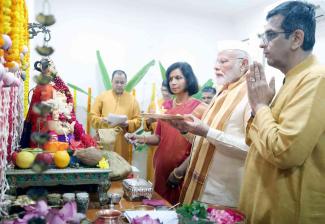Among India's many new normals, it is now also normal for the Prime Minister to visit the Chief Justice at his residence to take part in a 'private' religious function for the sake of organised publicity. Prime Minister Modi wearing a Maharashtrian cap and offering prayers to Lord Ganesh at CJI Chandrachud's residence on the occasion of Ganesh Chaturthi is now international news.
The Prime Minister has clearly killed several birds with this one single stone. From the Sengol ceremony on the occasion of the inauguration of the new Parliament building to the completely politicised 'consecration' of the newly built Ram temple in Ayodhya, he has never missed an opportunity to tell the world that the word secular in India's constitution has been totally subverted. The religious denomination of the majority community is now the de facto religion of the supposedly secular Indian state. The Ganesh Chaturthi photo op at the CJI's residence is only the latest statement in this series.
There is also the unmistakable Maharashtra angle in this entire incident. Ganesh Chaturthi, though increasingly observed in many states of India, is a quintessentially Maharashtraian festival. Narendra Modi made no bones of the fact that he was having Maharashtra in mind as his principal target audience. Along with English, he also posted this news in Marathi from his X handle. Needless to say, like every other Modi photo op event, this move is also driven by electoral calculations. Assembly elections in Maharashtra are just a few weeks away.
Modi has also sent out the message that he has the fullest backing and cooperation of the judiciary. The doctrine of separation of powers between the executive, legislature and the judiciary, the principle of independence of the judiciary and the norm of judges staying aloof from politics and maintaining a healthy distance from the executive have all been thrown out of the window. While we will perhaps never know whether the PM gatecrashed as a visitor or was invited by the CJI, the iconic photo and video will remain as historical evidence of the retreating judiciary in the face of an aggressive executive.
While Modi's calculations are easy to understand, the CJI's compulsion is difficult to fathom. From the charitable view of the CJI committing an error of judgement to the criticism of the judiciary becoming complicit in the executive's aggressive usurpation of greater power by subordinating other pillars of democracy, commentators have offered varying explanations to try and make sense of this unusual PM-CJI bonding.
While we may not have full explanation of each individual event, the context surrounding the interface between the judiciary and the current political establishment is too overwhelming to be missed. The Ranjan Gogoi episode is still fresh in public memory. Even more recent is the case of Kolkata High Court judge Abhijit Ganguly who took early retirement to join the BJP and is already a BJP MP from West Bengal. Several other judges in the Kolkata High Court and other courts have declared their association with the RSS soon after retirement. The penetration of the RSS in the judiciary and the resulting growing judicial lenience towards the Sangh brigade's fascist aggression, or even endorsement of the fascist agenda, is a shocking reality of our times.
Just the other day, as many as 30 former judges including two retired Supreme Court judges attended a daylong VHP brainstorming session on judicial reforms. Union Law Minister Arjun Ram Meghwal also addressed this session and posted about it from his X handle. Strangely, the VHP president Alok Kumar now calls it a mistake on the part of the Union Law Minister to publicise this closed door private event which revealed the identities of the participants. The topics discussed in this session, according to Kumar, included key elements of the Sangh Parivar’s agenda including the Waqf Board Amendment Bill, acquisition of temples, religious conversion and so on.
The Modi government has already made major changes in criminal codes and procedures and there are several major issues before the judiciary where the executive orders should ideally be reversed or restrained, as the Supreme Court had done eventually on the issue of Electoral Bonds.
The bonhomie between the PM and CJI cannot but be viewed against this backdrop. CJI Chandrachud repeatedly invokes the principle that bail is the rule and jail is an exception. He has even chided the lower courts for refusing to grant bail out of fear, possibly of bails being stayed by the higher courts. But in the case of Umar Khalid we have seen the hearing on Umar's bail petition being adjourned fourteen times by the Supreme Court, forcing the petitioner to withdraw the bail petition and return to the High Court. Which court is the Supreme Court of India afraid of? At a time when India is being sought to be reduced to a republic of fear and the executive is on a rampage with its bulldozer model of governance, the bonhomie between the Chief of the Executive and Chief of the Judiciary can only be seen as an alarming sign for the future of the Indian Republic.










